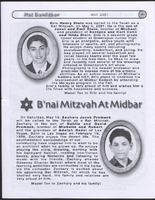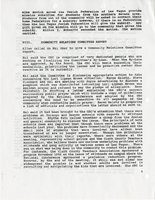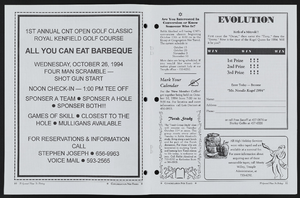Search the Special Collections and Archives Portal
Search Results
Tony Cordasco oral history interview, 2024 July 03
Level of Description
Scope and Contents
Oral history interview with Tony Cordasco conducted by Stefani Evans and Claytee D. White on July 3, 2024 for Game On! The Oral History of Las Vegas Sports project. In this interview, Tony Cordasco recalls his childhood in Newark, New Jersey, and eventually moving to Las Vegas, Nevada in 1979, where he became the first sports director of the new "KJON" radio station. In 1981, the station earned its FCC license as KUNV, and he was the first program director. After graduating with a degree in communications in 1982, he worked at news radio stations in Las Vegas and New Jersey until returning to Las Vegas permanently in 1987 to host a daily sports radio show and UNLV basketball play-by-play on a new station, KROL, co-owned by Sig Rogich and Mark Ratner. He also headed public relations for sports at The Showboat, which offered professional bowling, boxing, and wrestling. In 2000, he joined Red Bull as its marketing director and produced the company's first marketing plan. After fifteen years with the company, he opened his own consulting firm. He discusses his personal history with sports reporting and commentating and his work with Red Bull; the Professional Women's Volleyball team, Vegas Thrill; Jerry Tarkanian; and attending boxing matches at the Caesars Palace Sports Pavilion. Digital audio and photograph available.
Archival Collection
Collection Name: Game On! The Oral History of Las Vegas Sports Interviews
Box/Folder: Digital File 00
Archival Component
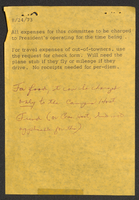
University of Nevada, Las Vegas law school planning: correspondence, meeting minutes, and clippings
Date
Archival Collection
Description
Folder contains materials related to establishing a law school at UNLV, including: lists of members on the Law School Advisory Board and Citizens Committee for Law School; draft booklet by the UNLV Pre-Law Advisory Committee; The National Pre-Law Newsletter, December 1974; Law School Admission Bulletin, 1974-1975; LSAT/LSDAS blank registration form; Law School Advisory Board meeting minutes, 1973-1974; Consolidated Students of UNLV resolution supporting the establishment of a law school, 1974; correspondence; published articles; and informational documents. From the University of Nevada, Las Vegas William S. Boyd School of Law Records (UA-00048).
Text
Red Rock Canyon National Conservation Area Records
Identifier
Abstract
The Red Rock Canyon National Conservation records (1965-2007) contain information about the Red Rock Canyon National Conservation Area (previously the Red Rock Canyon Recreation Lands). It largely consists of newspaper clippings on a variety of events related to Red Rock Canyon from 1965 to 1998 with the bulk from the 1980s and 1990s. The records also include Bureau of Land Management documents pertaining to interpretive efforts, visitation statistics, and law enforcement reports. Also included are the newsletters (1990-1998) and volunteer training manual of the Friends of Red Rock Canyon, a non-profit volunteer organization.
Archival Collection
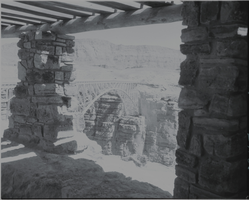
Film transparency of of the Navajo Bridge, Grand Canyon, Arizona, circa 1930s
Date
Archival Collection
Description
Image
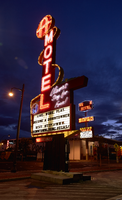
Photographs of The Ambassador Motel sign, Las Vegas (Nev.), April 28, 2016
Date
Archival Collection
Description
Site address: 9th St and Fremont St
Sign owner: Jackie Gaughan(ca.1952)
Sign details: Opened ca. 1940 by Joseph Mikulich but was called Ambassador Auto Court, Jackie Gaughan renamed it in 1952 as "Jackie Gaughan's Ambassador East". This location closed down in 1996 and was demolished 2007. Currently this location holds a parking lot, but the sign was restored in 2013 and put back in its original location.
Sign condition: 5- Was recently restored and is in great condition.
Sign form: Pylon
Sign-specific description: The building has been demolished, the sign has been restored and put on Fremont street. It is large red signage with a googie style "A" on top that looks like an arch. Vertically are the letters " MOTEL" in red neon. In a ribbon fashion around the letters are chasing incandescent light bulbs. In smaller white letters used to say "Ambassador Motel East" but now it states "Llamas stay for free" in a cursive white neon font. Beneath the letters is a reader board.
Sign - type of display: Neon, Incandescents and backlit reader board.
Sign - media: Steel and plastic
Sign - non-neon treatments: Reader board and Incandescents.
Sign animation: Chasing
Notes: incandescent light bulbs.
Sign environment: This is located East side of Fremont Street across the street from Atomic Liquors.
Sign - date of installation: Circa 1950
Sign - date of redesign/move: 2013 Restoration
Sign - thematic influences: This sign has been a part of the recent trend to restore old signs on Fremont Street to keep the downtown neon culture alive.
Sign - artistic significance: This sign has a retro 50's/ 60's motel sign trend to it.
Survey - research locations: Las Vegas Sun Article -https://lasvegassun.com/news/2013/jun/21/joe-downtown-motel-long-gone-ambassador-sign-being/ Classic Vegas website -http://classiclasvegas.squarespace.com/classic-las-vegas-blog/2007/12/19/the-ambassador-east.html Vintage Las Vegas Website -http://vintagelasvegas.com/search/Ambassador+Motel+
Surveyor: Wyatt Currie-Diamond
Survey - date completed: 2017-09-17
Sign keywords: Pylon; Neon; Incandescent; Backlit; Chasing; Steel; Plastic; Reader board; Back to back
Mixed Content
Hope Anstett oral history interview
Identifier
Abstract
Oral history interview with Hope Anstett conducted by Claytee D. White on December 8, 2003 for the Boyer Early Las Vegas Oral History Project. In this interview, Anstett talks about moving to Las Vegas, Nevada in 1939 with her mother and brother after a doctor recommended a move to a drier climate. Her mother rented a home from Senator Key Pittman and opened a photograph studio and dress shop in the front, with the family living in the back. She describes what it was like growing up in a small community, the schools she attended, the Las Vegas High School Rhythmettes drill team, and the activities available including Helldorado Days and the local recreation center. Later she discusses what the city was like during the war years, the family's move to Oregon, graduating from college, and getting married. She explains that she moved back to Las Vegas while her husband was deployed with the military and worked until his return and the birth of their first child. She also talks about her civic activities, her husband's career with Silver State Disposal, and their post-retirement travel and philanthropic work with the University of Nevada, Las Vegas (UNLV).
Archival Collection
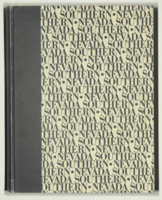
Epilogue: Nevada Southern University Yearbook, 1964
Date
Description
Yearbook main highlights: schools and departments; detailed lists with names and headshots of faculty, administration and students; variety of photos from activities, festivals, campus life, and buildings; campus organizations such as sororities, fraternities and councils; beauty contest winners; college sports and featured athletes; and printed advertisements of local businesses; Institution name: Nevada Southern University, Las Vegas, NV
Mixed Content

